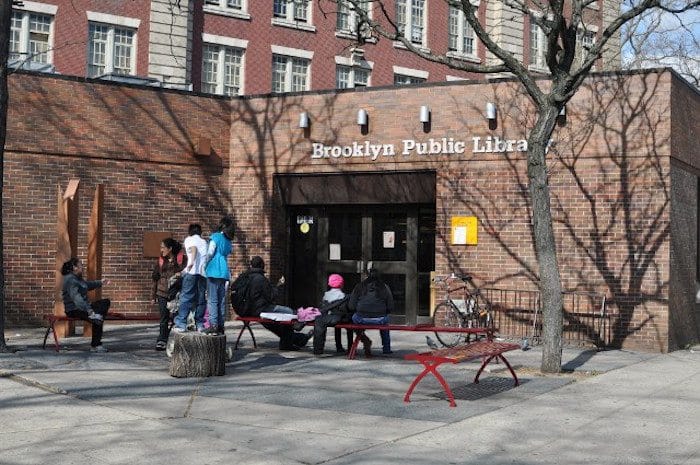Librarians Respond: Is Technology At The Library Bad For Kids?


A recent DPC article announcing that a state grant would bring video game consoles (along with other technology) to every branch of the Brooklyn Public Library drew some skeptical remarks from commenters who doubted the expenditure was a good use of library resources.
To follow the story, this reporter spoke with librarians at the Cortelyou Road branch, who had some insightful responses to the conversation. Many said that equipment purchased with the grant money supports several popular programs and provides a vital community resource: equal access to technology for education, job searching, and even reading programs.
One of the library’s roles is to bridge the “digital divide,” or the uneven access to technology based on income that’s a prominent feature of 21st-century America. The library has always been a place where people could get practical or cultural knowledge regardless of their economic status, the librarians agreed.
Libraries provide learning opportunities like computer and keyboard skills necessary to get a job. “We get a lot of people coming in here that may not know as much about technology,” said children’s librarian Ashley Bressingham. The additional computers, particularly laptops, will make it possible to expand those classes.

The grant was designed to make sure that all branches in Brooklyn have access to a baseline of technology resources. In addition to the video game consoles, that includes desktop and laptop computers and charging stations, a flat-screen television, and littleBits, an electronic building set.
Playing games isn’t the only thing kids — and adults — do with the library technology, explained Caitlin Wilson, the branch’s Library Information Supervisor. Patrons search for employment and fill out job applications, but limited access has put a strain on that service.
“It’s a real struggle when they’re filling out an application, especially ones that don’t save. Because you can’t finish it in half an hour, and there’s a line of people waiting,” Wilson said.
She said grant money would be used to get more computers so people can have more time to use them.
Many comments were underpinned by a disappointed conviction the technology at the library comes at the expense of reading. “We can all be glad those kids won’t be reading books, yuck,” wrote commenter junkyardwillie sarcastically. But all three librarians rejected the notion that youngsters don’t read anymore.
“People are still reading books,” said children’s librarian Liz Blake said. “We have people in here every day asking for recommendations for books.”
“Kids do read!” librarian Ashley Bressingham “Sometimes it’s harder to get them into it, but it always comes down to finding the right book for the right kid.”

The grant will give more ways for librarians to turn kids on to reading, Bressingham said. Her ‘Story Time’ class, where librarians read aloud to kids from infants to 5-years-old, is already one of the library’s most popular programs. “There are a lot of great apps on Ipads that have interactive books,” she said, and the grant will Ipads to the library too, make it possible to integrate those into the Story Time sessions.
“A lot of kids use our space for everything,” Blake added. “They use it for their social room, they use it for homework, they use it for doing their own stuff on the computers.”
Even some commenters who were enthusiastic about the library’s role in sharing technology expressed some suspicion that the equipment funded by the grant would deliver the goods.
“Perhaps the BPL press release would have been more informative if it gave some examples of exactly how this ‘technology’ would be used for STEM education,” wrote FlatbushFred. (STEM stands for Science Technology Engineering and Math.)
Blake’s experience with the littleBits kits, electronic, lego-type building blocks kids can connect by magnets, is one such example. “That’s something that most of the kids who are using the library are not going to have at home,” said Blake, who runs the library’s weekly Game On program. “They’re very expensive.” She’s already used them to great success with the library’s younger patrons.

Many of the negative online responses focused on the inclusion of X-Box and PS4 consoles in the list of equipment purchased with the grant. Commenter The Intelligent Reader called it “the libraries [sic] contribution to the dumbing down of America.”
Commenter Susana said, “I already forbid my children from going to the library at Cortelyou/Argyle because all they do is use the computers to play games, or watch over other kids’ shoulders.”
Bressingham had a different take. “Everyone needs to have fun in their life. While the library is a place to get educational resources, it’s also a place for fun. We want kids to come to the library.”
According to Wilson, the first wave of purchases funded by the grant, which established a starter kit of technology for every Brooklyn branch, has been completed. There may be additional spending, and while the central office will decide what to buy next, they will rely on feedback from librarians and library patrons about the hardware already in place.
You can weigh-in on the library’s technology program online through the library’s contact form here.




